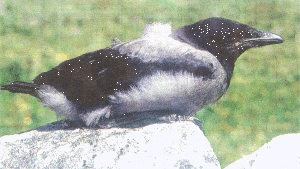
Survival of the fittest in animal world |
 THE mystery bird from last
week's column has split the birding world. Some experts say categorically
that the juvenile was a sedge warbler, while others have plumped for goldcrest
and firecrest. THE mystery bird from last
week's column has split the birding world. Some experts say categorically
that the juvenile was a sedge warbler, while others have plumped for goldcrest
and firecrest.
My bet is with the latter, although have to confess that I dismissed firecrest at first and went with the similar goldcrest because I thought the firecrest was too rare to be plausible. Several readers agreed with me on this count and the quickest off the draw was Steve. He did not leave his surname, but in an attempt to identity him his e-mail includes 'yaffle'. So Steve, please call at the Advertiser office to collect your goody bag. As we go to press, there may be other views coming in, and if there is any change to this identification I will let you know. But Steve, will still keep his prize. Just goes to show there are puzzles left for all of us. Even some of my birding friends who have forgotten more than I know went into cyberspace argument mode as the picture was beamed to Orkney, Ireland and Glossop and back. One common thread ran through the e-mails. Every reader asked after the health of the bird and I can confirm that the bird gathered its strength and flew off to a nearby tree. While on the subject of young birds, my mail bag in all of its forms has bulged with requests from readers for advice on the caring of, injured, lost and abandoned fledglings. Firstly, let me say that nine times out of 10 the birds are none of the above. In fact, they were probably waiting for the next meal from mum when a best-intentioned bird lover picked them up. For a start, ground nesting birds will have young which are on the ground including pheasants, lapwings and ducks (on the ground is where they live). Most young chicks will scatter when disturbed and can sometimes appear to be on their own. The likelihood is that the parents will be close by. If they could speak, the birds would probably ask for their young to be left alone. One reader explained how she had to take a mallard duckling home because the parent duck was struggling in the water nearby with a broken wing. I am not sure whether she was convinced when I explained that the adult was using a diversionary tactic, ie, pretending to have an injury to draw the predator away When she asked, "Which predator? I replied, "YOU". Some common garden birds will also be found on the ground, but do not worry, they may have just grown out of the nest or had a bumpy maiden flight. Either way, the parent birds will continue to feed them. In these instances, I would have to confess that the fledglings become more at risk from cats, but would still advise readers to leave well alone. Not least,because the feeding of young birds is a skilled and full-time job. Milk and bread, freshly dug worms and mincemeat are fine if you are a hedgehog, but a tiny seed eating bird is unlikely to thrive. Unless a bird is obviously injured please leave well alone, and even then seek expert help. Although it is sad. sometimes there is nothing one can do to prevent young birds and indeed other juvenile animals from dying. Look at the beautiful hooded crow pictured above on the island of Oilean Maisean (Mason Island) off the coast of County Galway. Moments earlier, four of them jostled for space in a seaweed nest on the chimney stack of a long deserted house. As if motivated by a subliminal sign, the 'hoodies' launched themselves skyward on their inaugural flight. Each bird in turn crash landed. Within seconds, two greater black backed gulls appeared out of nowhere and ripped the crows to pieces. Perhaps an extreme example, but if I had moved to frighten away the gulls they would have been back as soon as I was gone. And if I had taken the crows with rne, how would I have fed them, especially as I was leaving far England the next day. It's a tough world out there.
[The Advertiser
May20,2004] |
Related Articles |